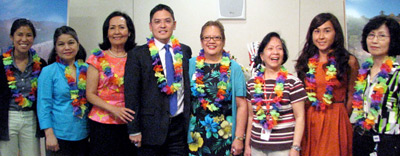Search News
For the Media
For media inquiries, call CWA Communications at 202-434-1168 or email comms@cwa-union.org. To read about CWA Members, Leadership or Industries, visit our About page.
Asian-Pacific American Heritage Month


CWA Headquarters celebrates Asian-Pacific American Heritage Month during May 2013. Darren Shiroma, Executive Assistant to Veda Shook, the International President of AFA-CWA, opened the celebration with lunch, brought in by Asian-Pacific Islanders here at CWA, and the following comments.
May is Asian-Pacific American Heritage Month – a celebration of the contributions and heritage of Asians and Pacific Islanders in the UnitedStates. Asian Pacific Islander (“API”) is very broad term, since there areapproximately 60 different and distinct ethnicities within that categorization.
Like most commemorative months, Asian-Pacific Heritage Month originated in a congressional bill. In June 1977, Reps. Frank Horton of New York and Norman Mineta of California introduced a House resolution that called upon the president to proclaim the first ten days of May as Asian-Pacific Heritage Week. The following month, senators Daniel Inouye and Spark Matsunaga introduced a similar bill in the Senate. Both were passed. On October 5, 1978, President Jimmy Carter signed a Joint Resolution designating the annual celebration. Twelve years later, President George H.W. Bush signed an extension making the week-long celebration into a month-long celebration. In 1992, the official designation of May as Asian-Pacific American Heritage Month was signed into law.
The month of May was chosen to commemorate the immigration of the first Japanese to the United States on May 7, 1843, and to mark the anniversary of the completion of the transcontinental railroad on May 10, 1869. The majority of the workers who laid the tracks were Chinese immigrants, making many of their living descendents the 5th to 6th generation of Americans today.
In October 2009, President Barack Obama signed an executive order restoring the White House Initiative and President’s Advisory Commission on Asian Americans and Pacific Islanders to address issues concerning the Asian American and Pacific Islander community. President Bill Clinton established the executive order 10 years earlier. Part of President Obama’s executive order read, “the more than 16 million Asian Americans and Pacific Islanders (AAPI) across our country have helped build a strong and vibrant America. The AAPI communities represent many ethnicities and languages that span generations in America, and their shared achievements are an important part of the American experience.” President Obama’s personal remarks in 2009 read: “when I talk about America's AAPI communities, I'm talking about my own family: my sister, Maya; my brother-in-law, my beautiful nieces; and the folks I grew up with in Indonesia, and in Honolulu, as part of my Hawaiian Ohana, or family.”
President Obama’s half-sister Maya, who was named after the American poet Maya Angelou, is half-Indonesian, half-white (they share the same mother, Ann Dunham), and is fluent in English, Spanish and Indonesian – Maya’s husband is half Chinese, half Malaysian. So, President Obama comes from a family makeup what we affectionately call in Hawai’i, a “mixed plate” (coined from the type of lunch that we are about to partake in). When the first immigrant laborers were brought to Hawai’i in the 1800s, they each brought their own dishes for lunch in the plantation fields. As a community, they eventually shared dishes from their different cultures, making a hodgepodge of tastes and flavors - and many of those “mixed plate” lunches still bear the signature fare from nearly 170 years ago.
Thanks to Zenia and Isabel for helping coordinate today’s festivities, and to all of you who cooked and brought the food we are blessed with today.
On behalf of the Asian Pacific Islander colleagues here in the building, MAHALO (that’s thank you in Hawaiian) SALAMAT PO (that’s thank you in Filipino/Tagalog) KAMSAHAMNIDA (in Korean). THANK YOU for joining us today, and thank you for embracing our lineage, our heritage, and our cultures!